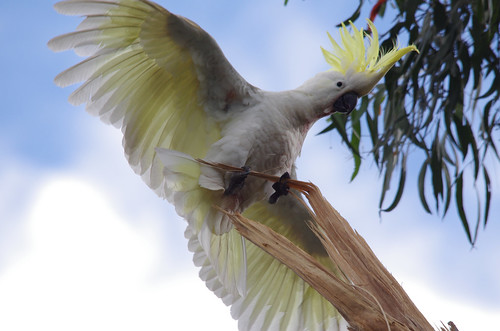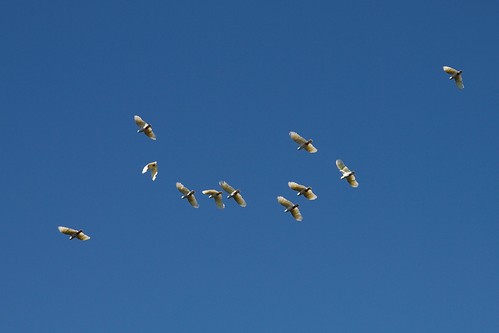 Suburban Sulphur-crested Cockatoo exploring the exposed fresh timber. Image by Ralph GreenBRISBANE suburbs are alive with the blood-curdling screech of handsome sulphur-crested cockatoos.
Suburban Sulphur-crested Cockatoo exploring the exposed fresh timber. Image by Ralph GreenBRISBANE suburbs are alive with the blood-curdling screech of handsome sulphur-crested cockatoos.
Often cursed by residents because of their propensity to eat anything and everything, it's that time of year for cockies to be having babies and raising young.
Cockatoos have increased their range since white settlement in some places like Perth, WA, where they were introduced either as cage escapees or deliberately released.
But the beautiful bird that has been described as having a call like a sheet of corrugated iron being dragged across a bitumen road has always inhabited the greater Brisbane area.
University of Queensland's Hugh Possingham said it was possible there were more cockatoos now living in the area than before whites arrived.
 This flock of cockatoos made quite a lot of noise flying over the Mt Cootha Botanical Gardens in Brisbane, Australia. Image by Christoph Rupprecht"When settlers arrived the country was a lot less forested than it is now and they did a lot of clearing for agriculture," he said. "Since then the area has effectively been re-forested, with people planting trees.
This flock of cockatoos made quite a lot of noise flying over the Mt Cootha Botanical Gardens in Brisbane, Australia. Image by Christoph Rupprecht"When settlers arrived the country was a lot less forested than it is now and they did a lot of clearing for agriculture," he said. "Since then the area has effectively been re-forested, with people planting trees.
"It's taken a long time for these trees (to become valuable wildlife refuges) because cockatoos need such big hollows."
Cockatoos also had learned to use exotic trees.
"Cockatoos are very smart," he said. "They rival dogs in intelligence and are getting close to chimpanzees. They have worked out how to capitalise on different foods in the urban setting.
"They are quite exploratory and quickly learn things. They work out which seeds are edible from introduced plants and then pass that information on to offspring.
"As well, 100 years ago people were trapping parrots for the bird trade. Cockatoos know people aren't trapping or shooting them any more so they've become a lot tamer."
Foundation for National Parks and Wildlife chief executive Steve Corbett agreed: "If you see a cockatoo waiting patiently on a public drinking fountain, don't be afraid to approach slowly and turn it on. Some ... have worked out this is a great place for a drink."
Mr Corbett said although they were enjoyable to watch, they were prone to stripping bark, branches and leaves from trees to keep beaks trimmed and sharp.
Last year a north Queensland landlord complained about a cockatoo which was allowed to fly free in a house. It chewed architraves and doors, causing more than $20,000 worth of damage and there have been complaints of them tearing into fruit trees, verandas, powerlines and decks.
"If you regularly feed cockies, you might come home one day to find a few waiting for you and stripping timberwork, window sills or decking," he said.
Queensland Museum inquiry centre officer Steve Wilson said cockies were common at places such as Everton Park, Kurwongbah, Wooloowin and Redlands, east of the city.
He rarely received complaints about them despite their noisy and gregarious groups.
"You will always get someone complaining about something but they aren't a significant issue," he said. "It's terrific to see them around."